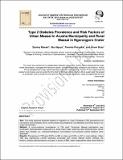| dc.description.abstract | Aim: The study explored potential impacts of migration on Type 2 Diabetes (T2D) prevalence and
risk factors across Maasai ethnic communities living traditional rural lifestyles and those living in an
urban environment.
Method: A cross-sectional investigation of 724 adult Tanzanian Maasai participants was
conducted. Anthropometric measures (i.e., body mass index; waist-hip ratio; blood glucose, serum
lipids) plus lifestyle (i.e., diet/alcohol/tobacco consumption) and physical activity patterns were
assessed.
Results: Prevalence of T2D was 22.9% (n=80) in urban and 9.9% (n=37) in rural settings. Urban
T2D was significantly (<0.05) positively correlated with known obesity marks, lifestyle risk
factors, systolic blood pressure, and age. In terms of BMI, urban respondents were more likely to be overweight (p<0.001) than their rural counterparts. As well, urban respondents ate more meals
per day (p<0.001) and consumed more alcohol (p<0.001). Of note, the increase in urban
prevalence related to age is significantly (p<0.05) more pronounced in males than females. In rural
settings, increased FBS was significantly negatively correlated with age, and and significantly
(p<0.05) positively correlated with obesity markers, with 46% being assessed by BMI as
underweight. The activity levels, assessed by distances walked, had rural Maasai with significantly
greater distances (P<0.0001).
Conclusion: The study demonstrated an increase in T2D for those Maasai adopting more
sedentary urban life styles. As a result, it is important for health programs to recognize the impacts
of lifestyle changes in contributing to increasing prevalence in non-communicable diseases such
as T2D. | en_US |

